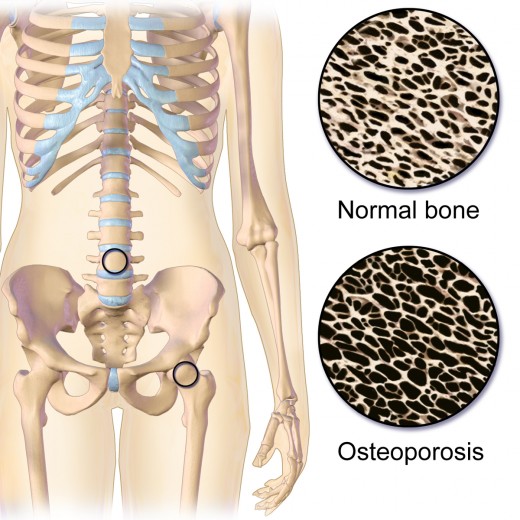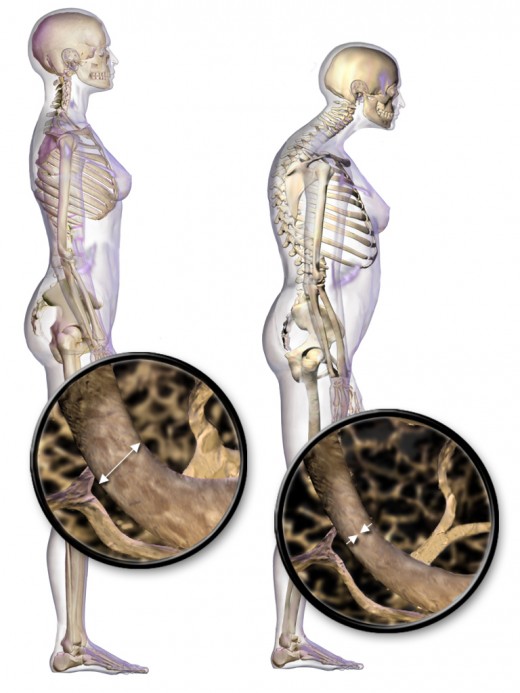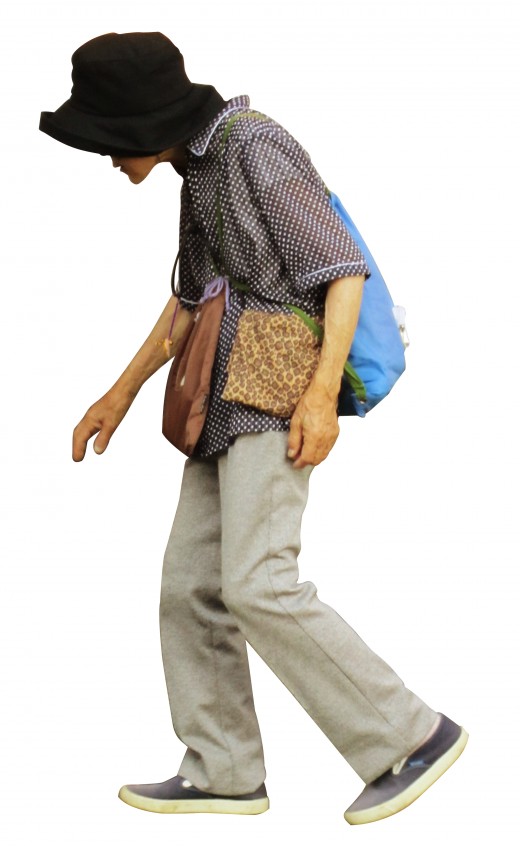Key Information About Osteoporosis
Osteoporosis is defined as a bone density T score of -2.5 or below. Worldwide, this medical condition causes more than 8.9 million fractures annually, resulting in an osteoporotic fracture every 3 seconds.
Silent Thief
"Known as the “silent thief,” osteoporosis is a disease that thins and weakens bones to the point where they break easily," said Dr Elena Volpi.

Causes
Osteoporosis can be caused due to various reasons, including calcium deficiency, low estrogen or testosterone levels, surgical removal of ovaries, kidney problems, hyperthyroidism, low peak bone mass, hormonal imbalance, anorexia and vitamin D deficiency.
Calcium
"Osteoporosis continues to be a major and common health issue. Bones are made up of calcium and store 99% of the calcium in the body while the remaining only 1% is stored & utilised in blood, muscles, and tissues. If you are not getting calcium from your daily diet, your body pulls it from your bones to sustain other functions that are very important for immediate survival. Also, some amount of calcium is continually excreted in the urine. So, if your dietary intake does not compensate for what is lost, your bones will lose calcium over time, which will lead you to the risk of developing osteoporosis," said nutritionist Lovneet Batra in her Instagram post.
Air pollution ‘speeds up osteoporosis’ in postmenopausal women.
An American study finds bone loss occurs twice as fast among women living in areas with higher air pollution.
The research study scanned the bones of more than 9,000 women living in four different parts of the USA. Each had a bone scan three times over a six-year period that was compared with the air they breathed. On average, air pollution accounted for a doubling of the speed of bone loss.
The the team found that particle pollution increased the number of incidents of people being taken to hospital with fractures by 8 percent in their study group.
Dr Diddier Prada, from the United States of America study team at Columbia University’s Mailman School of Public Health, said: “The global population is getting older because of increased life expectancy and declining birth rates. We should identify, and eliminate, critical factors that affect human health during ageing. Postmenopausal women are susceptible to bone fractures and reductions in bone mineral density because of oestrogen reduction but also air pollution. Further action is needed to reduce air pollution from diesel vehicles and wider fossil fuel use to protect public health. These may result in enormous reductions in hospitalisation, costs, and even mortality.”
The US researchers found the lumbar spine was most susceptible to air pollution-induced bone loss and especially from nitrogen oxides.
NCFB
Osteoporosis is an independent risk factor for all-cause mortality in hospitalized patients with non-cystic fibrosis bronchiectasis (NCFB), according to a study conducted in March 2023 and published in BMC Pulmonary Medicine.
Healthy Person Vs Osteoporosis Patient

Risk Factors
Risk factors for developing osteoporosis include a sedentary lifestyle, use of glucocorticoids, smoking and having inflammatory arthritis, among others.
Symptoms
Silent Disease
The condition is often called a "silent disease" because bone loss can happen slowly and without any warning signs.
Back pain, weight loss, stooped posture and easily breakable bone are some known symptoms of osteoporosis.
Stooped Posture Is a Symptom of Osteoporosis

Pathophysiology
Osteoporosis is a condition of skeletal fragility characterized by reduced bone mass and microarchitectural deterioration of bone tissue with a consequent increase in risk of fracture. Low bone mass is thus visualized as a risk factor for fracture.
Even sneezing or a minor fall could lead to fracture when one is suffering from the condition.
Diagnosis
Osteoporosis remains significantly underdiagnosed. It is diagnosed via bone mineral density scans known as bone densitometry or dual-energy x-ray absorptiometry, or DXA, also written as DEXA.
Treatment
Many orthopaedic surgeons are of the opinion that early diagnosis and treatment can help reduce fracture risk.
Women younger than 75 years and men under 60 years can expect to live at least 15 more years after beginning treatment.
Randomized clinical trials among women and men aged 50 years and older have shown that those with clinically recognized osteoporosis benefit significantly from drug treatment that prevents fractures.
Oral Bisphosphonates
Providers often recommend oral bisphosphonates for osteoporosis due to their effectiveness and relative affordability.
Bisphosphonates, like alendronate (Binosto, Fosamax), ibandronate acid (Boniva), and risedronic acid (Actonel, Atelva) treat osteoporosis by keeping the body from breaking down bone.
Abaloparatide is a parathyroid hormone-related protein analog medicine. It is an anabolic agent that was approved to treat postmenopausal osteoporosis in the USA in the year 2017.
Never self-medicate without the advice of a doctor because the risk of atypical femur fractures increases with prolonged use of bisphosphonates.
Yoga can be a beneficial addition to your osteoporosis treatment. It may help ease symptoms, improve bone health, and lower your risk of complications.
Many scientific studies and experiments have recorded an increase in bone mineral density among people who had a history of osteoporosis and practised the below mentioned asanas:
- Tadasana
- Triyak Tadasana
- Katichakrasana
- Trikona asana
- Ardha Matsyendra Asana
Resistance exercises for osteoporosis can build bone density, which can reduce a person’s risk of fractures and breaks.
Low-intensity vibration therapy offers an innovative way to prevent and combat osteoporosis, that may assist existing support services.
In October 2023, research scientists from the Marcus Institute for Aging Research identified specific bacteria in the gut microbiome linked to skeletal health. This study was published in the journal Frontiers in Endocrinology.
Akkermansia and Clostridiales
Research scientists found two specific types of bacteria in the gut microbiome — Akkermansia and Clostridiales bacterium DTU089 — linked to negative associations with bone health for older adults.
“We do not precisely know why these bacteria would be connected to skeletal health, but we do know that Akkermansia abundance in the intestine is linked to obesity and that obesity may be related to compromises in skeletal integrity,” Dr. Douglas P. Kiel, professor of medicine at the Marcus Institute for Aging Research at Harvard Medical School and Beth Israel Deaconess Medical Center, and principal investigator of this study told Medical News Today.
Another bacteria in the gut microbiome called Faecalibacterium prausnitzii has been linked to helping with bone formation and produces butyric acid, which can assist with regulating bone metabolism.
Although some research studies have reported the beneficial effects of sesame oil in osteoporosis patients, the exact mechanism of action is not well understood.
In a research study, Professor Tadayoshi Hayata, Mr. Takuto Konno, and Ms. Hitomi Murachi from Tokyo University of Science, and their co-workers, delved into the molecular regulation of osteoclast differentiation.
Receptor activator of nuclear factor kappa B ligand stimulation induces the differentiation of macrophages into osteoclasts.
Further, bone morphogenetic protein and transforming growth factor (TGF)-b signaling pathways have been implicated in the regulation of RANKL-mediated osteoclast differentiation.
In the study, research scientists sought to investigate the role of Ctdnep1 - a phosphatase (an enzyme that removes phosphate groups) that has been reported to suppress BMP and TGF-b signaling.
Giving further insight into their work set to be published on July 30, 2024, in Volume 719 of Biochemical and Biophysical Research Communications, Prof. Hayata states, "RANKL functions as an 'accelerator' for osteoclast cell differentiation.
Driving a car requires not only the accelerator but also the brakes. Here, we find that Ctdnep1 functions as a 'brake' on osteoclast cell differentiation."
First, the scientists examined the expression of Ctdnep1 in mouse-derived macrophages treated with RANKL and untreated control cells.
They noted that Ctdnep1 expression remained unchanged in response to RANKL stimulation.
However, it localized in the cytoplasm in granular form in the macrophages and differentiated into osteoclasts, distinct from its normal peri-nuclear localization in other cell types, indicating its cytoplasmic function in osteoclast differentiation.
Further, Ctdnep1 knockdown (downregulation of gene expression) resulted in an increase in tartrate-resistant acid phosphatase-positive (TRAP) osteoclasts; wherein TRAP is a marker for differentiated osteoclasts.
Additionally, Ctdnep1 knockdown led to an increase in the expression of crucial differentiation markers including 'Nfatc1', a RANKL-induced master transcription factor for osteoclast differentiation.
These results support the 'brake function' of Ctdnep1, whereby, it negatively regulates osteoclast differentiation.
Moreover, Ctdnep1 knockdown also led to increased absorption of calcium phosphate, suggestive of the suppressive role of Ctdnep1 in bone resorption.
Lastly, while, Ctdnep1 knockdown did not alter BMP and TGF-b signaling, cells deficient in Ctdnep1 showed elevated levels of phosphorylated (activated) proteins downstream of the RANKL signaling pathway.
These findings suggest that the suppressive effect of Ctdnep1 in osteoclast differentiation may not be mediated by BMP and TGF-b signaling, but, through the negative regulation of RANKL signaling and Nfatc1 protein levels.
Overall, these findings provide novel insights into the process of osteoclast differentiation and reveal potential therapeutic targets which can be pursued to develop treatments that address bone loss due to excessive osteoclast activity.
How best to treat patients with osteoporosis is a really simple issue when it comes to beginning treatment, but deciding how long to treat for is really very challenging.
— Dr Bo AbrahamsenPrevention
No matter your age, you can take steps to build bone mass and prevent bone loss.
Include prunes (aka dried plums) in your diet. They are healthy for your joints and bones. If eaten regularly, they can prevent bone loss as well.
Prunes include polyphenol compounds, which work as antioxidants that help reduce inflammation and reconstruct the bone.
Prunes are also loaded with potassium which is good for bones. They are abundant in copper, magnesium, and vitamin K, all of which are crucial for maintaining strong bones.
One of the research studies on the fruit, published in February 2023 in the journal Advances in Nutrition, demonstrated through clinical trials that eating 10 prunes daily for one year improved bone density in the forearm, lower spine, and knees and helped protect bones by slowing or reversing bone issues.
“Arthritis and osteoporosis are two of the most common health problems that affect the bones. People having these conditions suffer from symptoms such as bone pain, stiffness, swelling, inflammation, decreased range of motion, lower back pain, and bone loss. To deal with these conditions and prevent such issues you need to make sure to include prunes in your diet,” said Dr Rakesh Nair, Consultant knee replacement Surgeon at Zen Multispeciality Hospital, Chembur, Mumbai.
Include low-fat dairy products, dark green, leafy vegetables, tofu, almonds, orange juice, cereals, and breads in your diet.
Milk is good for your bones. The reason being, milk is a wonderful source of calcium — one of the two nutrients that can help your bones retain strength.
Ensuring an adequate calcium intake is important. Adults aged 19 years and above should consume 1,000 milligrams (mg) a day. Women aged 51 years and over, and all adults from 71 years should have a daily intake of 1,200 mg.
Acidic food items like meat and sweets could take away calcium out of the bones. Avoid them.
Regular exercise is essential. Adults aged 19 to 64 should do at least 150 minutes of moderate-intensity aerobic activity, such as cycling or fast walking, every week.
A post-supper stroll is a solid way to strengthen your skeletal system. “Walking is another weight-bearing activity that stimulates muscle/bone 'chatter,' keeping the bones strong,” Dr. Serota says.
It doesn’t need to be a major time commitment either. A quick 15-minute walk can do wonders for your bone health, especially when you do it every day.
Do yoga daily. Vrksasana (Tree Pose), Trikonasana (Triangle Pose), Setu Bandhasana (Bridge Pose), Supta Padangustasana (Reclining Hand-to-Big-Toe Pose) and Savasana keep the bones strong and healthy.
Many experts are of the opinion that yoga is critical to bone health. It improves bone density and facilitates absorption of nutrients.
Adding weight-bearing activities like running, plyometrics, or weight lifting to cross-training can help make your bones stronger and reduce your osteoporosis risk.
Getting enough sunlight is important for your vitamin D levels. Not getting enough vitamin D from sunlight or your diet can cause a deficiency, which harms your bones.
According to a study conducted in August 2022, there is a particular variety of cheese that could beat bone loss – it is Jarlsberg. The study was published in the BMJ Nutrition, Prevention & Health journal.
A research study conducted in March 2024 found that public greenness and natural environments could reduce the risk of incident osteoporosis regardless of genetic predisposition. Developing sustainable and publicly accessible natural environments might benefit populations' bone health.
- Hydrolyzed egg yolk peptide prevented osteoporosis
Hydrolyzed egg yolk peptide (YPEP) was shown to increase bone mineral density in ovariectomized rats.
Summary
- Osteoporosis is defined as a bone density T score of -2.5 or below.
- Vitamin D can cause osteoporosis.
- Use of glucocorticoids increases the risk of osteoporosis.
- Back pain is a symptom of osteoporosis.
- DXA is used to diagnose osteoporosis.
- Bisphosphonates are used to treat osteoporosis.
- Yoga can prevent osteoporosis.
Do you practice yoga daily?
This content is accurate and true to the best of the author’s knowledge and does not substitute for diagnosis, prognosis, treatment, prescription, and/or dietary advice from a licensed health professional. Drugs, supplements, and natural remedies may have dangerous side effects. If pregnant or nursing, consult with a qualified provider on an individual basis. Seek immediate help if you are experiencing a medical emergency.
© 2019 Srikanth R








